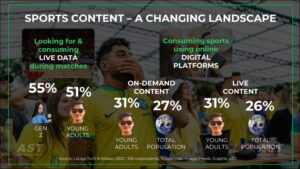
An immersive and informative viewing experience
There is an increasingly prominent trend on the part of the fan, to be interested in the game details. Accessing a higher degree of insight than was previously demanded, and this is something that technology is already delivering. It is not uncommon to see how leagues, clubs, and competitions, through mobile technology, can deliver new match experiences that are far more immersive than they were years ago to their fans. Virtual experiences such as watching players emerging from the tunnels, coach speeches in dressing rooms, access to a huge range of camera angles with which to watch a replay, 3D graphics, and interactive games are just a few examples of the great innovations being driven by sports IPs.
This growth is related to the desire of fans to constantly engage with a third screen. Thanks to mobile technology (in the stadium and at home), fans are looking to extract more information from matches. For example, during the World Cup in Qatar, FIFA launched a platform where fans could access and interact with individual and collective metrics through AR technology.
There is also a high demand for increasing real-time access to conversations between players, coaches, and even referees, having the possibility to watch live discussions about relevant decisions, through digital devices. This is something that still has a long road ahead, although there are already sports disciplines that are leading these kinds of activities. In Major League Soccer (MLS), refereeing decisions are broadcast live on the screens of the stadium; an example that will be implemented soon in the Premier League.
Another big trend in 2022 has been the huge increase of digital venues in the metaverse. The aim has been to offer new alternatives to the connection between fans, brands, and clubs, a space to offer new experiences, consumption models, and community creation.
Data for precision
One of the biggest challenges the clubs face is to optimize the relationship with fans and to centralize, digitize and exploit all the Club’s data. To understand this, we talked to Clupik, a startup leading the digital transformation of sports clubs.
“We are increasingly observing a rising trend in data adoption among fans and supporters, who are seeking in-depth insights about their favorite clubs and teams. Thanks to platforms like Clupik, sports organizations can now provide an accurate and up-to-date view of their activities, enabling better communication and transparency with their sports community.”
When it comes to performance data, in recent years there has been an outrageous increase in the democratization of the collection of match and training data (events and tracking). In addition, accessing more semi-professional and grassroots leagues has grown greatly thanks to AI technology and its automatic cameras.
On the other hand, 41% of global sports fans are watching at least some sporting events via OTT platforms According to LaLiga Tech & Nielsen: 360º Fan Engagement report. The integration of sports data on OTT platforms is extremely valuable as it enables direct access to data and analysis of fan behaviour; allowing sports properties to understand and engage with fans more effectively. OTT platforms are deployable and it is full of monetization opportunities in Asia, as they can be bundled with data analysis, fantasy sports, social media, and other kinds of digital activations.

Richard Pinnick, SVP of Global Business Development at Fortress (an access, payments, loyalty and fan engagement platform trusted by the biggest teams in Europe and North America) exclusively shared with us some insights on how sports IPs can navigate digitized sports fandom: “Sports teams traditionally prefer to disintermediate the fan through third-party channels – broadcast, social, gaming, e-commerce – even with ticketing.
The next generation will see teams taking ownership of their own fan identity, and in doing so controlling the gateway to services provided. Others may still provide the service – but through the ecosystem owned and managed by the brand. Whether this is played out at a team level or league level is still undetermined. Sports teams may ultimately not want to become platform businesses but remain content creators and this opens the opportunity for the League to step in and build the platform.
Ultimately, it’s about data, and how the industry uses data to make “every fan count” – no matter whether the fan is sitting in the stadium, is in a bar with his friends or is engaging with content online or the metaverse.
32% of Gen Z fans watch live sporting events via licensed streaming channels, a significant shift when compared to the 24% of all US adults. Teams have had to adapt – from upgrading stadium infrastructure to deliver high speed WIFI, through to the implementations of AR, VR, drone-eye tech, live data and stats, and ‘back-of-seat’ 2nd screens – all are designed to make the experience more accessible and more akin to the digital storytelling that makes up some much of the Gen Z world.” said Pinnick
Social media: Complementing in-game experiences
Social media has cemented its position as a key channel for fans to interact with sports brands, especially for Gen Z. With a high smartphone adoption rate and a whopping number of active social media users, leagues and teams have been leveraging the power of social media content to complement live sports experiences. Learn how AST helped Juventus to grow its brand in China.
Richard from Fortress explains, “With the increased cost of attending live sports, more young people are turning to social media channels to access their sporting content. The content they demand is also different – whilst the live experience is still important, its only one piece of the puzzle. This means that Teams are having to be increasingly focused on the game beyond the game – how to create content and experiences that gel with today’s world of social media, with its personalities, fashion interests, and general first-person video content.“
Southeast Asia has an enormous online sports community that can be capitalized on. When live sports first returned in 2021, Tweets about sports went up from 2.7 billion to 3.7 billion globally compared to the previous year while Southeast Asia itself garnered over 95 million sports-related Tweets in 2021, which saw a 40% increase from 2020; Conversations around F1 among Southeast Asians also skyrocketed and witnessed a 121% year-on-year growth according to Maurizio Barbieri, Twitter’s ex-Head of Sports Partnerships, Southeast Asia.
The majority of global sports fans are based in Asia, and it’s challenging for them to travel overseas to watch live games frequently. These fans religiously follow their favourite sports teams, leagues or athletes on social media, but have never attended a match inside a stadium. Even on TV, live matches from western sports I.Ps are broadcast at odd hours of the night, making social media and exhibition games extremely important in Asia.
We spoke to Leo MacLehose, CEO of Fanzo, a global fan activation platform that helps 6 million fans annually access local sports venues that show their games on TV: “Sport is no longer just about the consumption of live content, so many of the most malleable, innovative fan engagement opportunities live in the down periods between fixtures/events. It’s also the areas that are the most available for brands to activate around their chosen sports events. From Fantasy and Predictors, to Trivia, gamification provides the opportunity for rights holders to engage more directly with fans, and create sponsorable experiences.
Rights holders have very little direct engagement with their audiences, as they have mostly sold these on to the broadcasters. The size of their CRMs show very low audience penetration, as the only consistent source of fan data is their stadiums.
Out of Home (pubs, bars and fan zones) is an untapped and unconsolidated market, which rights holders and partners could exploit to access fans more directly. Creating opportunities for brands and partners to access data and deeper fan engagement in physical locations.”
Gamification
Leagues and teams need to be strategic to engage with their fans globally, turning it into active engagement from passive consumption and ultimately retaining loyalty. We see an increasing number of platforms that not only allow us to watch content but also to interact with it. This includes apps that launch gamified challenges during matches, skills tests to win rewards linked to their favorite clubs, or even fantasy platforms that seek to reward the winners of each matchday by predicting the performance of their teams. AST has covered how fantasy sports have taken over the region, especially with India being the world’s largest fantasy sports market.
Ian Kenny, CEO of Filmily – An automated fan engagement platform mentioned: “Gamification will obviously attract a younger audience with potentially more disposable income. The nature of the way that content is consumed has changed, audiences are more likely to want shorter highlights rather than the complete game or series.”
Web3-integrated fan loyalty programs are accelerating and full of possibilities as we previously highlighted, while Kenny believes understanding fan engagement in Web3 is the challenge facing Sports IPs and Sponsors: “I think the biggest challenge for sports franchises and their sponsors is understanding and overcoming the challenges of web 3.0. Filmily uses UGC to connect with fans in a number of unique ways, rather than as a blanket ‘fan engagement company’.” said Kenny.
Importance of content localization
To effectively engage fans, it is essential to localize your offerings, such as integrating content/activations strategies with different local languages and cultures. AST previously spoke to Matthew Marsh, GoF1 Show Presenter and an expert in the Asian motorsports arena who said: “Localization is key to growing its fan base in Asia: like a local TV Show. Local brands sponsoring these shows will go a long way, like what NBA did in China.”
Ivan Codina, Managing Director of LaLiga, SEA – Australia, Japan & South Korea, also shared with AST that they communicate in local languages and create localized content that Asian fans can relate to. For example, in Indonesia, La Liga has nearly 9 million followers engaged across 6 different platforms, including through a Twitter account in Bahasa. They are currently on more than 20 social media platforms worldwide, with over 25 languages.
There is no one size fits all approach when it comes to fan engagement, especially when fans across different demographics and geographies consume sports very differently.
Reach out to us to learn about how to leverage data, technologies, social media, and content to grow your fan base in Asia.
LET’S CONNECT


